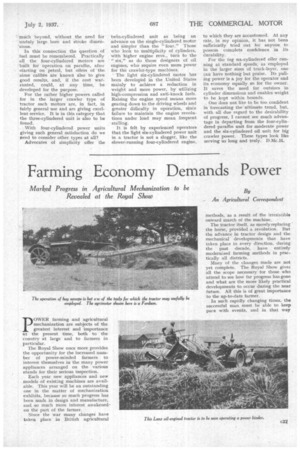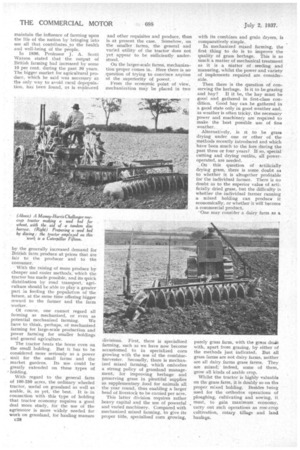Farming Economy Demands Power
Page 73

Page 74

If you've noticed an error in this article please click here to report it so we can fix it.
Marked Progress in Agricultural Mechanization to be Revealed at the Royal Show
By An Agricultural Correspondent pOWER farming and agricultural mechanization are subjects of the greatest interest and importance at the present time, both to the country at large and to farmers in particular. .
The Royal Show once more provides the opportunity for the increased number of power-minded farmers to interest themselves in the many power appliances arranged on the various stands for their serious inspection.
Each year new appliances and new models of existing machines are available. This year will be an outstanding one in the matter of mechanization exhibits, because so much progress has been mack in design and manufacture, and so much more interest awakened' on the part of the farmer.
Since the war many changes have taken place in British agricultural
methods, as a result of the irresistible onward march of the machine.
The tractor itself, as rnerelyreplacing ' the horse, provided a revolution. But the advance in tractor design and the mechanical developments that have taken place in every direction, during the past -decade, have entirely modernized farming methods in practically all districts.
Many of the changes made are not yet complete. The Royal Show gives all the scope necessary for those who attend to see how far progress has gone and what are the more likely practical developments to occur during the near future. All this is of great importance to the up-to-date farmer.
In such rapidly changing times, the successful man must be able to keep pace with events, and in that way maintain the influence of farming upon the life of the nation by bringing into use all that contributes to the health and well-being of the people.
In 1936, Professor J. A. Scott Watson stated that the output of British farming had increased by some 10 per cent, during the past 30 years. The bigger market for agricultural produce, which he said was necessary as the only way to avoid rural depopulation, has been found, as is evidenced by the generally increased demand for British farm produce at prices that are fair to the producer and to the consumer.
With the raising of snore produce by cheaper and easier methods, which the tractor has made possible, and its quick distribution by road transport, agriculture should be able to play a greater part in feeding the population of the future, at the same time offering bigger reward to the farmer and the farm worker.
Of course, one cannot regard all farming as mechanized, or even as potential mechanized farming. We have to think, perhaps, of mechanized farming for large-scale production and power farming for smaller holdings and general agriculture.
The tractor beats the horse even on the small holding. But it has to be considered more seriously as a power unit for the small farms and the market gardens. Its use could be greatly extended on these types of • holding.
With regard to the general farm of 100-250 acres, the ordinary wheeled tractor, useful on grassland as well as arable, is, as yet, the best. It is in connection with this type of holding that tractor economy requires a good deal more study, for the use of the agrimotor is more widely needed for work on grassland, for hauling manure c28 and other requisites and produce, than is at present the case. Somehow, on the smaller farms, the general and varied utility of the tractor does not yet appear to be sufficiently understood.
On the larger-scale farms, mechanization-proper comes in. Here there is no question of trying to convince anyone of the superiority of power.
From the economic point of view, mechanization may be placed in two divisions. First, there is specialized farming, such as we have now become accustomed to in specialized corngrowing with the use of the combineharvester. Secondly, there is mechanized mixed farming, which embodies a strong policy of grassland management, for improving herbage and preserving grass in plentiful supplies as supplementary food for animals all the year round, thus enabling a larger head of livestock to be carried per acre.
This latter division requires rather heavy capital and the use of powerful and varied machinery. Compared with mechanized mixed farming, to give its proper title, specialized corn growing, with its combines and grain dryers, is comparatively simple.
In mechanized mixed farming, the first thing to do is to improve the quality of grass herbage. This is as much a matter of mechanical treatment as it is a matter of seeding and manuring, whilst the power and variety of implements required are considerable.
Then there is the question of conserving the herbage. Is it to be grazing and hay? If it be, the hay must be good and gathered in first-class condition. Good hay can be gathered in a good state only in good weather and, as weather is often tricky, the necessary power and machinery are required to make the best possible use of fine weather. . .
Alternatively, is it to be grass drying under one or other of the methods recently introduced and which have been much to the fore during the past three or four years? If so, special cutting and drying outfits, all poweroperated, are needed.
On this question of artificially drying grass, there is some doubt as to whether it is altogether profitable for the individual farmer. There ia no doubt as to the superior value of artificially dried grass, but the difficulty is whether the individual farmer running a mixed holding can produce it economically, or whether it will become a commercial product.
One may consider a dairy farm as a
purely grass farm, with the grass deait with, apart from grazing, by either of the methods just indicated. But all grass farms are not dairy farms, neither are all dairy farms grass farms. They are mixed; indeed, some of them, grow all kinds of arable crop.
Whilst the tractor is highly valuable on the grass farm, it is doubly so on the proper mixed holding. Besides 'being used for the orthodox operations of ploughing, cultivating and sowing, it must, to gain maximum economy, carry out such operations as row-crop cultivation, rotary tillage and land haulage.




















































































































































